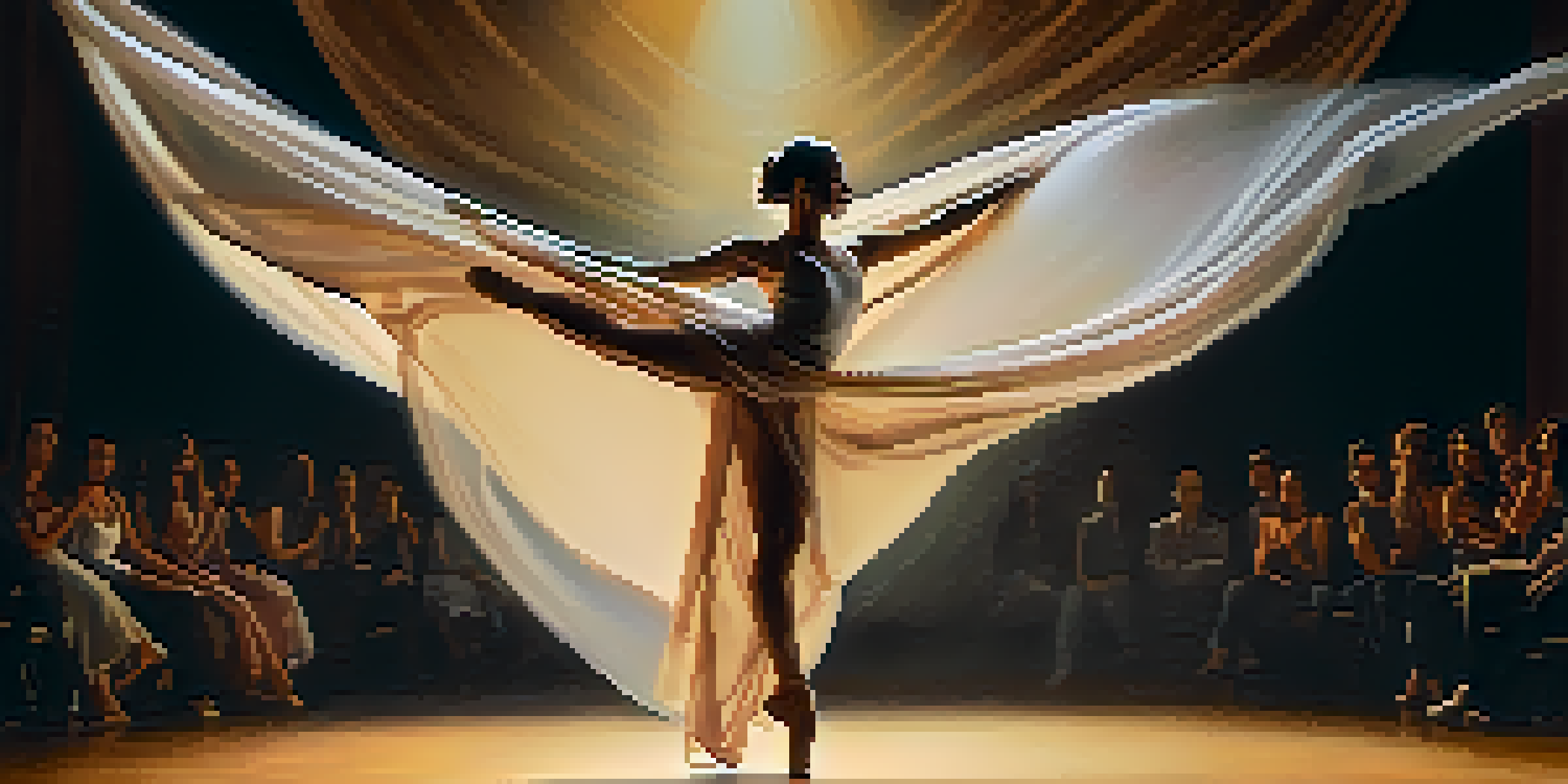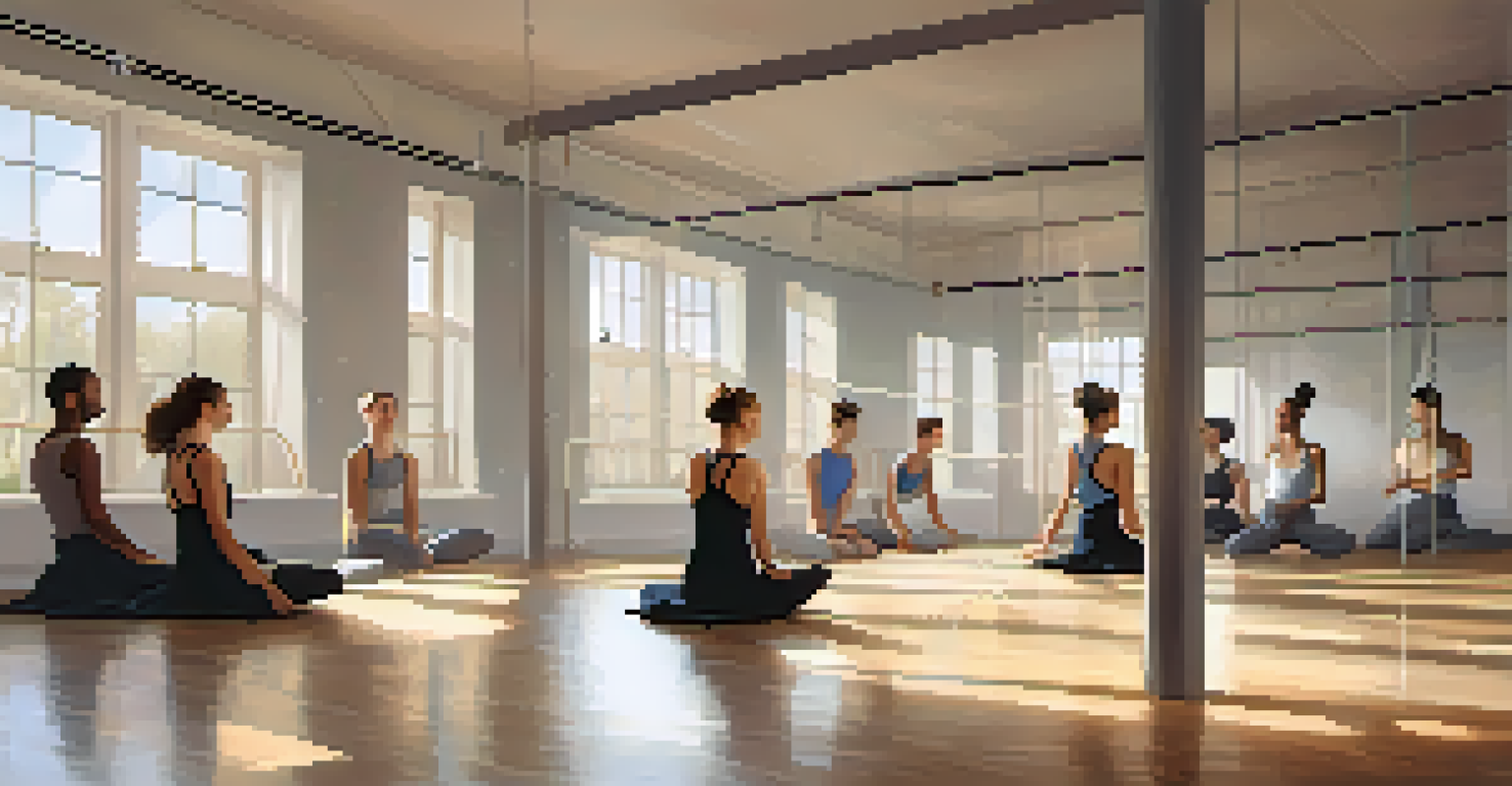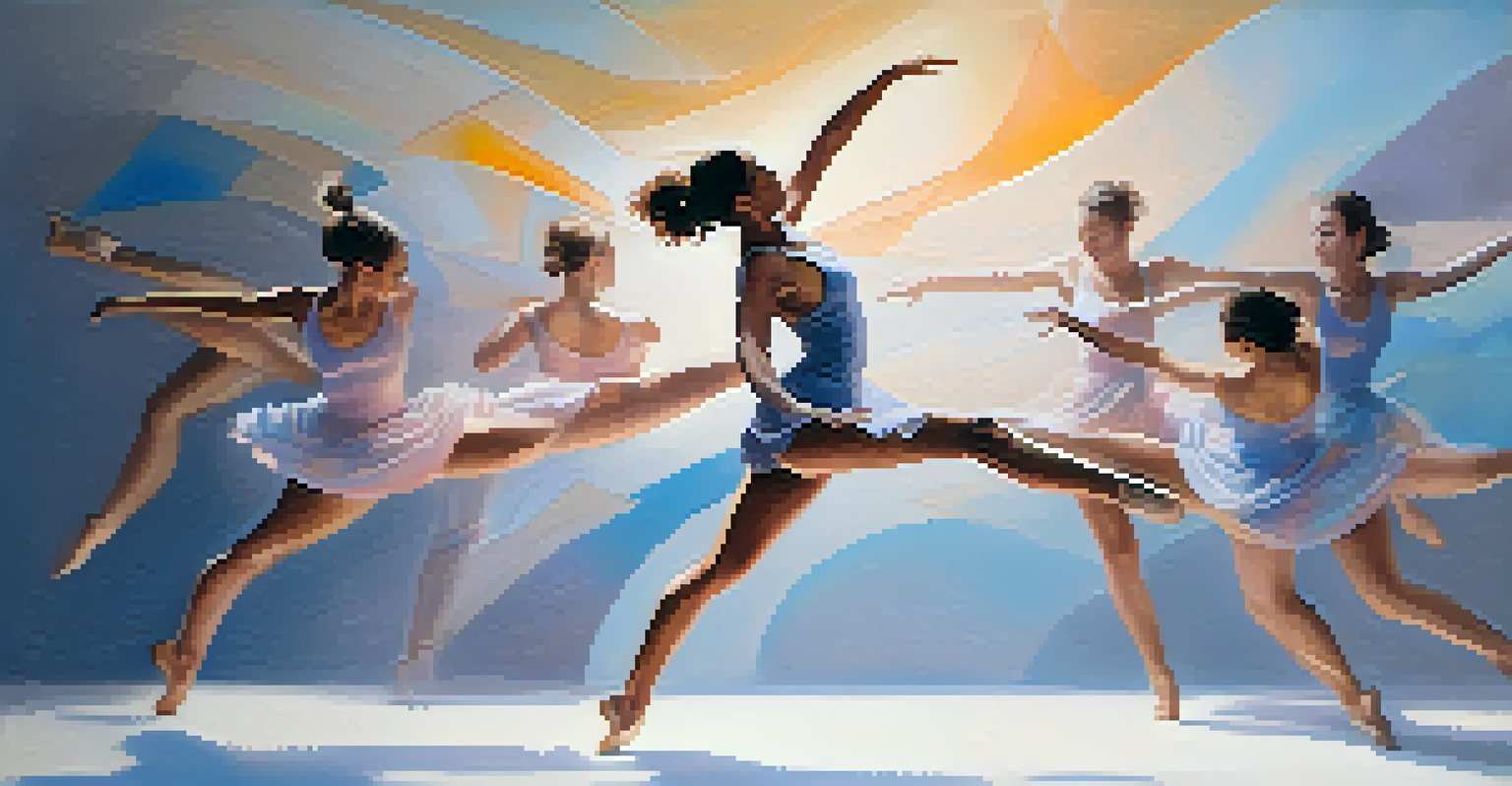Mindfulness in Dance: Enhancing Body Awareness and Presence

Understanding Mindfulness in Dance
Mindfulness in dance refers to the practice of being fully present while moving. This means not just going through the motions but truly experiencing each step and movement. By focusing on the sensations in your body, dancers can cultivate a deeper connection to their art form. It’s about finding a rhythm that resonates not just with the music, but also with your inner self.
Dance is the hidden language of the soul.
Imagine standing on stage, the lights dimming, and the music begins to play. Instead of worrying about your next move or how the audience perceives you, you immerse yourself in the moment. Each beat guides your body, and you become acutely aware of how your feet touch the floor and how your breath syncs with the rhythm. This connection transforms a performance into a shared experience.
Incorporating mindfulness techniques into dance practice can foster a sense of calm and clarity. Techniques like focused breathing or visualization can help dancers release tension and enhance their physical awareness. Ultimately, mindfulness can help dancers express themselves more authentically and effectively.
The Benefits of Body Awareness in Dance
Body awareness is crucial for dancers as it allows them to understand their physical capabilities and limitations. Knowing how your body moves helps prevent injuries and enhances overall performance quality. When dancers are aware of their body, they can execute movements with greater precision and grace, making their performances more impactful.

Think of body awareness like a dancer's internal compass. When you know where your body is in space, it's easier to make adjustments and transitions smoothly. This heightened awareness can also lead to a more profound interpretation of choreography, as dancers can infuse their personal emotions and experiences into their movements.
Mindfulness Deepens Dance Connection
Practicing mindfulness allows dancers to fully immerse themselves in each movement, creating a deeper emotional connection to their art.
Moreover, improved body awareness can lead to increased confidence. Dancers who understand their body mechanics are more likely to take risks and explore new styles or techniques. This exploration can open doors to creativity, allowing for unique expressions that captivate audiences.
Mindfulness Techniques for Dancers
Dancers can incorporate several mindfulness techniques into their routines to enhance awareness and presence. One effective method is mindful breathing, where focusing on your breath can help ground you in the moment. This practice can be as simple as taking a few deep breaths before starting a dance or during rehearsals to center your thoughts.
Mindfulness is a way of befriending ourselves and our experience.
Another technique is body scanning, where dancers mentally check in with different body parts to identify areas of tension or discomfort. By acknowledging these sensations, dancers can adjust their movements accordingly, promoting better alignment and reducing the risk of injury. This practice encourages a deeper understanding of how emotions can influence physical sensations.
Finally, visualization can be a powerful mindfulness tool. Imagining each movement and its flow before executing it can create a mental roadmap, helping dancers navigate their choreography with ease. This not only enhances performance but also builds a strong mental connection to the dance.
Creating a Mindful Dance Environment
To cultivate mindfulness in dance, it's essential to create an environment that supports this practice. This could mean setting aside a quiet space free of distractions, where dancers can focus on their movements and breathing. Whether in a studio or at home, a serene environment can enhance the ability to concentrate and connect with the dance.
In addition, incorporating calming elements like soft lighting or gentle music can help foster a mindful atmosphere. These elements can encourage relaxation, allowing dancers to immerse themselves in the experience without outside stressors. A mindful environment acts as a sanctuary for personal expression and exploration.
Body Awareness Prevents Injuries
Understanding body mechanics enhances performance precision and reduces the risk of injuries for dancers.
Lastly, encouraging open communication within a dance group can promote mindfulness. Sharing experiences and feelings can help dancers feel supported, creating a safe space where they can explore their emotions through movement. This sense of community fosters stronger connections among dancers, enhancing the overall experience.
How Mindfulness Enhances Performance Quality
Mindfulness can significantly enhance a dancer's performance quality by promoting focus and concentration. When dancers are fully present, they can perform movements with intention and clarity, making every gesture meaningful. This level of engagement captivates audiences and adds depth to the performance.
Moreover, mindfulness allows dancers to adapt to unexpected changes during a performance. Whether it’s a missed cue or an unplanned moment, being present enables dancers to react fluidly and maintain their composure. This adaptability can turn potential mishaps into opportunities for creativity and improvisation.
Additionally, the practice of mindfulness can reduce performance anxiety. By focusing on the here and now, dancers can quiet their racing thoughts and enjoy the moment. This shift in mindset can lead to a more enjoyable and fulfilling performance experience.
Mindfulness and Emotional Expression in Dance
Dance is often a form of emotional expression, and mindfulness can deepen this connection. When dancers are mindful, they can tap into their emotions more readily, allowing them to convey feelings through their movements. This emotional authenticity resonates with audiences, creating a powerful connection.
Think of a dancer interpreting a poignant piece of music. With a mindful approach, they can channel personal experiences into their performance, crafting a narrative that reflects their story. This emotional depth elevates the performance from mere technique to a heartfelt expression.
Mindfulness Boosts Performance Quality
Being present during performances enhances focus, adaptability, and emotional expression, resulting in a more captivating experience for audiences.
Furthermore, mindfulness encourages vulnerability, which is essential for authentic expression. Dancers who embrace their emotions are more likely to take risks and push boundaries, inviting the audience to experience a range of feelings alongside them. This shared emotional journey can transform a dance into an unforgettable experience.
The Role of Mindfulness in Dance Training
Incorporating mindfulness into dance training can significantly enhance learning and retention. When dancers practice mindfully, they are more likely to internalize movements and choreography. This approach allows for a deeper understanding of the material, making it easier to execute complex routines.
Moreover, mindfulness can foster resilience in dancers. By embracing challenges and setbacks as part of the learning process, dancers can build a strong mental foundation. This resilience not only improves their technical skills but also enhances their overall enjoyment of the art form.

Finally, integrating mindfulness into training can create a positive and supportive atmosphere. Encouraging dancers to be present and mindful cultivates a culture of respect and encouragement. In this environment, dancers can thrive, pushing each other to grow both as performers and individuals.